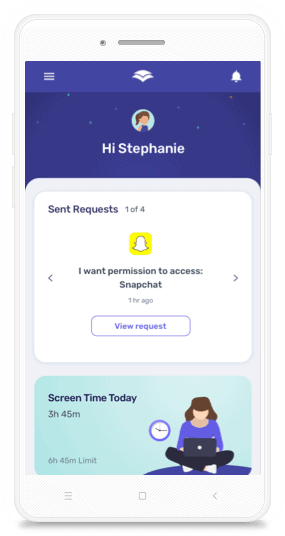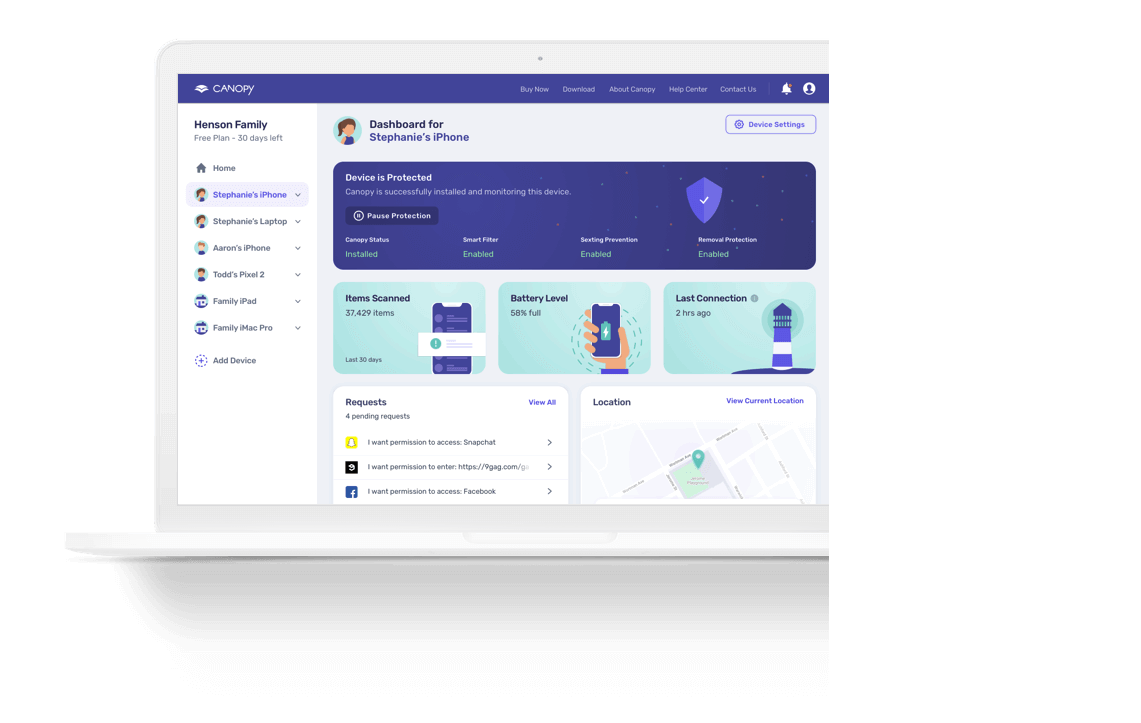When selecting a screen time app, consider features like customizable screen limits, content filtering, and ease of use. Look for an app that grows with your child’s needs and supports a balanced approach rather than overly strict restrictions. Canopy is a great option for parents looking for flexible, real-time protection and screen time management.
Raising kids today requires an awareness of screen time that our own parents did not have to deal with to the same extent. You may have wondered whether a screen time app can help you out in this regard. But what exactly does such an app do, what are its benefits, and what do you need to know before choosing one for your child? Read on to discover the answers to all those questions, and more!
What Are Screen Time Apps?
Parents can choose to manage screen time on the device level (for instance, by using Apple Screen Time if their kid has an iPhone) or sometimes, on the app level (TikTok has introduced screen time “breaks”). However, for various reasons, it sometimes makes sense for parents to use a dedicated screen time app.

These apps have risen in popularity as children’s screen use has skyrocketed. Studies show that kids and teens today spend many hours per day on screens, doomscrolling on social media, playing games, and doing schoolwork. It’s not uncommon for a teenager to average well over 8 hours a day of screen media use! It’s easy to see why parents worry about the impact on sleep, schoolwork, and family time. Screen time apps were created to tackle this very problem by helping families set boundaries around technology use.
Importantly, screen time apps are just one part of the broader digital wellness movement. Tech companies and app developers are recognizing that people (especially children) need help unplugging and using devices in healthy ways. The idea isn’t to flee from technology – which can be educational and fun – but to prevent overuse and negative effects. A good screen time app should empower parents and kids to find a balanced approach: enjoying the benefits of technology while avoiding the downsides of too much screen time.
Benefits of Using Screen Time Apps
When used thoughtfully, screen time apps can provide several benefits for both children and parents. Here are some of the key advantages:
- Improve mental health. The list of detrimental effects resulting from screen time (and associated causes, like the specific app being used) include a wide range of social and psychological impacts. For instance, a girl is more likely to be exposed to material espousing the benefits of an eating disorder if she spends a lot of time on social media than if she is growing up screen-free. Likewise, a boy is more likely to suffer the ill-effects of excessive exposure to pornography if he has constant access to it via a device with internet access.
- Lessen distractions. On the extreme end of the spectrum, screen time can cause an addiction to… screen time! But even for a child who is not clinically addicted, digital devices do distract from more important endeavors (such as school) and studies have even shown that the mere presence of a phone in a child’s pocket may result in worse academic performance.
- Give them more time for what matters. An hour spent on social media could be an hour lost with family. Or getting exercise. Or experiencing the great outdoors. You get the idea! We only have so much available time after subtracting school and sleep from every 24-hour span – why waste it on endless hours of doom-scrolling?
- Protect their eyes. Studies have shown that excessive screen time (and/or a lack of time spent outdoors) can contribute to nearsightedness, a condition which affects more and more of the population (and especially children) every year.
In short, a good screen time app can act as training wheels for digital life – guiding children toward healthier habits, keeping distractions in check, and giving parents oversight and peace of mind. It’s having house rules that are automatically enforced by technology, so there’s less nagging and more consistency.
Drawbacks and Concerns of Screen Time Apps
You may be thinking, “Sounds great! But what’s the catch?” There are a few things to keep in mind before looking for a screen time app for your child.
- Not a magic fix for parenting challenges: It’s critical to remember that no app can replace active parenting and guidance. There’s a risk of over-relying on the software to do the heavy lifting. If we simply set strict limits without explaining to kids why we’re doing so, children might not internalize those lessons. They may follow the rules only because the app forces them to, rather than learning self-control. This means when the restrictions are not in place (for example, they are at a friend’s house or eventually go off to college), they could end up binging on screens. Screen time apps should be a tool, not a substitute for teaching kids healthy habits and time management. Relying on them as a “set it and forget it” solution is better than nothing, but it can give a false sense of security.
- Potential for conflict or reduced trust: Rigid enforcement of screen limits can sometimes lead to power struggles and frustration, especially with older kids. If a teenager feels the controls are too strict or that parents are “spying” on them, it can breed resentment. Some studies have found that heavy use of monitoring and control software can increase family conflict or make kids feel less trusted. It’s easy to see why: imagine a pre-teen who tries to open an app and finds it blocked – they might feel frustrated and argue, or try to get around the rules. If parents implement a screen time app without discussing it with their child beforehand, the child may feel it as a sudden clampdown on their freedom. This erosion of trust can harm the parent-child relationship. For this reason, experts often suggest using these apps openly and as part of an agreed “family tech plan”, rather than sneaking them in or using extreme restrictions that can provoke rebellion.
- Impact on child’s autonomy and privacy: As kids grow, they naturally seek more independence. Relying too long or too heavily on screen time controls might hinder a teen’s ability to practice decision-making. If every online action is dictated or watched, a kid may not learn to regulate themselves. There’s also the privacy aspect: older children might feel that constant monitoring of their messages or app usage is an invasion of privacy. Striking the right balance is tricky – parents want to protect their kids, but those kids deserve some breathing room to develop their own judgment. Over-control can backfire, leading children to become secretive in an attempt to reclaim some privacy. In some cases, tech-savvy teens have found ways to bypass screen time apps, using tricks like VPNs, private browsing, or simply using a friend’s device. This cat-and-mouse game isn’t healthy for family dynamics.
In the next section, we’ll discuss how to strike a healthy balance — using screen time apps in a positive way without undermining your child’s independence or your relationship with them.

Tips for Balancing Screen Time and Autonomy
Achieving digital wellness in your home isn’t just about installing an app and walking away. It’s about thoughtful parenting and finding the middle ground between guidance and freedom. Here are some tips for using screen time apps as part of a balanced approach:
- Communicate and involve your child: Before you start using a screen time app (or when introducing new rules on an existing one), talk to your child about it. Explain the reasons – for example, “We want to make sure you get enough sleep and time for other activities, not just screens.” Listen to their concerns as well. If kids feel heard and understand that the goal is to help them (not just to punish or control), they are more likely to cooperate. For older children, consider setting the limits together. You might be surprised by their input; some teens acknowledge they spend too much time online and might help decide on fair rules. Involving them gives a sense of ownership and respect, which can reduce resentment. (Consider modelling good behavior, and setting device limits for yourself as well!)
- Set clear rules and be consistent: Consistency is key for any household rules, screen-related or not. As part of a “family tech agreement,” decide on core principles (such as “no devices after 9 PM” or “no gaming until homework is done”) and use the app to enforce those consistently. When the rules are clear and applied fairly each day, kids are less likely to argue each time. They know what to expect. That said, it’s okay to grant exceptions for special occasions (like a family movie night or a virtual class that runs late) – just make sure those are communicated as exceptions. Consistency paired with some flexibility for special cases helps children respect the system while understanding the reasoning behind it.
- Adapt as your child grows: What works for a 7-year-old will not be appropriate for a 16-year-old. Revisit your screen rules and app settings periodically (for example, at birthdays or the start of a new school year). As your child demonstrates more responsibility, grant them a bit more freedom. Maybe you increase their allowed screen time, or remove certain filters for a teen who can handle the broader internet responsibly. Gradually training wheels come off. This shows your child that the goal is for them to earn trust and self-regulate eventually. It’s important they know the controls aren’t permanent prison walls, but rather guardrails that will widen over time. By the later teen years, ideally the app’s role should shrink in favor of the teen’s own judgment (with your guidance in the background as needed). Using screen time apps with this long view in mind will help your child become more independent.
- Don’t skip the conversations: Even with a screen time app running, keep having regular conversations about online safety, cyberbullying, and digital etiquette. The app can enforce limits, but kids still need guidance on how to behave and stay safe online during the time they are allowed on. If you notice questionable activity, use that as a teachable moment.
By following these tips, you turn the screen time app from just a rule-enforcer into a part of a holistic parenting approach. You get the benefits of a technological tool, and your child gets the benefit of your parental wisdom and care.
Canopy: A Balanced Approach to Screen Time Management
With the pros and cons in mind, you might wonder if there’s a way to get the benefits of screen time apps without many of the drawbacks. The good news is that modern solutions are evolving to be more flexible and child-friendly. Canopy is one screen time app that stands out for its balanced approach to digital parenting. Rather than focusing only on shutting down devices after a timer, Canopy offers a comprehensive toolkit to help families manage technology in a healthy way.
So what makes Canopy different? For starters, it emphasizes customization and guidance over one-size-fits-all control. Parents can set screen time limits and schedule device-free times, just like many apps. But Canopy also allows you to tailor these settings to each child’s age and needs. This means you can easily adjust limits as your kids grow or as their responsibilities change. The app recognizes that a balanced approach is not static — it changes with your family.
Another big advantage of Canopy is its focus on keeping your child safe without completely handcuffing their internet experience. Canopy’s unique content filtering technology works in real-time to block pornography and explicit content before it ever reaches your child’s screen. It’s an AI-powered system that can even filter inappropriate images and videos on otherwise kid-friendly sites and apps. This way, you don’t have to resort to an extreme measure like shutting off the internet entirely to ensure a safe experience. Your child can explore the web and use educational or entertainment sites, with Canopy quietly filtering out the worst content in the background. This feature helps parents breathe easier knowing that even within their allowed screen time, kids aren’t going to accidentally run into something harmful. It strikes a balance by allowing more freedom with strong safeguards in place.
Canopy also understands the importance of building good habits. The app includes features to encourage device breaks and deter problematic behavior (for instance, it can detect when explicit photos are being taken or shared and alert a parent, which is a gentle way to deter sexting among teens). By addressing the content and behavior side of screen use, not just the minutes, Canopy aligns well with the idea that digital well-being is about how we use devices, not just how long. Parents can feel more confident granting screen time when they know Canopy is actively shielding their child from the most dangerous corners of the digital world.
From a parent’s perspective, Canopy keeps things simple and transparent. All the controls—from setting daily limits to pausing internet access for a family dinner—are easy to use in an intuitive app interface. The goal is to empower you to guide your kids, not to micro-manage every click. And by focusing on core concerns (like inappropriate content and sensible time limits) Canopy avoids the trap of being overbearing. Kids know it’s there to protect them, not to invade their privacy or catch them in a “gotcha” way. You can even use Canopy as a conversation aid: for example, if Canopy blocks a dangerous website, that’s a perfect opportunity to discuss with your child why that site isn’t acceptable.
Start your free trial of Canopy today, and help your family establish the right screen time balance in an evolving digital world.
Screen Time FAQ
What is a screen time app, and how does it work?
A screen time app is a tool that helps parents manage their kid’s device usage by setting time limits and scheduling screen-free breaks. These apps provide insights into device usage and encourage a healthy balance between online and offline activities.
Are screen time apps effective for managing kids' screen use?
Yes, a screen time app can be effective when used in conjunction with open communication and clear family guidelines. These apps help reduce distractions, promote digital well-being, and enforce screen limits, but they work best when combined with parental guidance.





